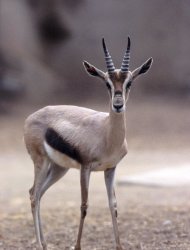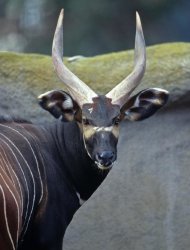More than two dozen species of hoofed animals
and birds, about half of them endangered, vulnerable or near
threatened, are being considered for the breeding center planned by the San Diego Zoo Global Wildlife Conservancy and New Orleans' Audubon Nature Institute.
"If two great zoos like San Diego and Audubon are going to team up" to breed endangered species,
"the birds are certainly going to benefit. And the animals," said
Kenneth Rosenberg, a senior researcher in the conservation science
department at the Cornell Laboratory of Ornithology, which is not part
of the new Alliance for Sustainable Wildlife.
The more common animals matter,
too, said Steve Shurter, director of White Oak Conservation Center in
Jacksonville, Fla. "Breeding centers are very, very important resources
to zoos. It's not that easy to source animals for collections," he said.
"And zoos have a very, very important role to play introducing people
to wild animals and the importance of conserving them."
Okapi are among the animals being considered. They are the only
living relatives of giraffes, with a white, giraffe-like head but a much
shorter neck and zebra-like stripes on their legs and haunches. They
are listed as near threatened. White Oak and the San Diego Zoo have
partnered for a quarter-century on the Okapi Conservation Project, using
the animals to help conserve the Congolese rain forest where they live,
Shurter said. Antelope under consideration include the bongo, which are large,
reddish-brown forest animals with white stripes and long horns. Also
being considered are scimitar-horned oryx, which are extinct in the
wild, and endangered Speke's gazelles — among the smallest of their
kind, up to 2 feet high at the shoulder and 40 pounds.
Antelope under consideration include the bongo, which are large,
reddish-brown forest animals with white stripes and long horns. Also
being considered are scimitar-horned oryx, which are extinct in the
wild, and endangered Speke's gazelles — among the smallest of their
kind, up to 2 feet high at the shoulder and 40 pounds.They all need lots of space for herds — something most zoos don't have, said Steve Feldman, spokesman for the Association of Zoos and Aquariums.
In general, zoos and other
conservation groups try to breed pairs likely to have the best genetic
match, he said. "But that two-by-two approach doesn't always work.
Sometimes it's better to put more animals together and sort of let them
pick," he said.
Birds will include the endangered
whooping and Mississippi sandhill cranes already at Audubon, with
vulnerable wattled cranes and Dalmatian pelicans among species under
consideration.
Ron Forman, president of the
Audubon Nature Institute, said the Alliance for Sustainable Wildlife
will use most of the 1,400 acres at the Audubon Species Survival Center,
where scientists began breeding endangered cranes, hoofed animals and
cats in 1996.
At least in the early stages, the birds will get a total of 10 acres while each kind of hoofed stock gets 15- to 50-acre enclosures, said Robert J. "Bob" Wiese, chief life sciences officer at San Diego Global. "The idea is, since we have all this space, let the antelope be antelope. Have the herds acting like herds."
At least in the early stages, the birds will get a total of 10 acres while each kind of hoofed stock gets 15- to 50-acre enclosures, said Robert J. "Bob" Wiese, chief life sciences officer at San Diego Global. "The idea is, since we have all this space, let the antelope be antelope. Have the herds acting like herds."
 Colonial bird species such as
milky storks and lesser flamingos would live in flocks, while others may
be paired in a series of neighboring breeding pens, he said.
Colonial bird species such as
milky storks and lesser flamingos would live in flocks, while others may
be paired in a series of neighboring breeding pens, he said.
Wiese and Forman said the project
evolved from the zoo association's work to get sustainable populations
of various species. It will help decide which birds and animals most
need the space, Wiese said.
Forman said Audubon has put more
than $30 million into the project and expects to spend another $10
million and more on new pens and paddocks, with the two zoos sharing
operating costs. Construction should start by the end of the year and
continue into 2018, with animals moving into the first enclosures next
year, he said.

No comments:
Post a Comment